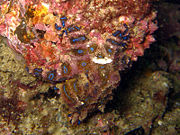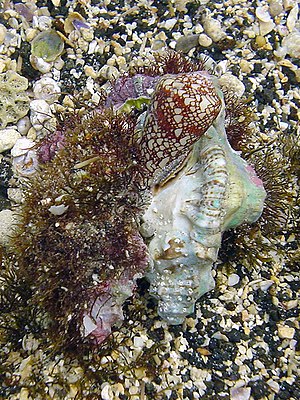Pedro Nuno Ferreira
Liquid Breathing
- Location
- Portugal - Vila Nova de Gaia
;-) Everyone, Hi LeslieS
Yesterday...hmmm...a few hours ago to be more exact...:tongue1:, I browsed some excellent threads here in the forum and came across this excellent Tank Girl (
 1 2 3 ... Last Page) thread by LeslieS. As I browsed through it a came across page 6, post n? 58 where I found this picture, of Snowball I believe
1 2 3 ... Last Page) thread by LeslieS. As I browsed through it a came across page 6, post n? 58 where I found this picture, of Snowball I believe
which I believe to be of a fire urchin Astenosoma varium or at least a sea urchin of the genus Astenosoma. Below you can see Astenosoma marisrubri, which as the species name indicates...marisrubri=Red Sea...is very beautiful but also very....Venomous
It was photographed in the Red Sea during a live aboard dive by my friend Julio Macieira also now a Manhattan reefs member and Reefforum.net administrator and owner.
Well I have this sticky thread about Organismos venenosos-perigosos do recife/Reef venomous-dangerous critters that I have been putting together post by post and other people are also contributing, to inform people dealing with these living reef jewels, about what may lurk beneath the dazzling beauty of many of them, which can in some cases be as both much fatal as it is dazzling beautiful.
Some two days ago or so, I noticed these two threads my fish almost killed me last night (
 1 2) and rabbitfish venom. Even before having noticed those to threads I had already decided to bring this other thread of mine to Manhattan Reefs because I don't want any one to get hurt, but there's several other things I want to bring over and share, however when finally I came across LesliS photograph above...well that was it...safety comes first so here it is. I'll be placing posts about all the critters I presently have covered in my original thread and will carry on with others not yet covered. If you have personal experiences and/or photographs or if you want to have a say about this or that critter, even if it is already covered, please do not hesitate to write a post. The more information we have the better can we enjoy safely our tiny bits of sea at home, school...and also out there in the sea while diving, or visiting the low tide zone.
1 2) and rabbitfish venom. Even before having noticed those to threads I had already decided to bring this other thread of mine to Manhattan Reefs because I don't want any one to get hurt, but there's several other things I want to bring over and share, however when finally I came across LesliS photograph above...well that was it...safety comes first so here it is. I'll be placing posts about all the critters I presently have covered in my original thread and will carry on with others not yet covered. If you have personal experiences and/or photographs or if you want to have a say about this or that critter, even if it is already covered, please do not hesitate to write a post. The more information we have the better can we enjoy safely our tiny bits of sea at home, school...and also out there in the sea while diving, or visiting the low tide zone.
Please understand that this is not to alarm, this is to inform, explain, help!
Echinoderm Envenomation
I think it is clear that these species are very beautiful but also dangerous...
Well this said, I could have mistakenly identified Snowball, but...please be careful LeslieS and everyone else as well...don't forget to use anti-puncture gloves.
I'm off to the sea now and will be back to write about the blue ring octopus....

...one thing more...LeslieS who's the manufacturer of that exquisite tank of yours...I really liked it. I have two triangular tanks, one of them bow front, and also have an hexagon and I have the place for one like yours...I like exquisite geometry for tanks...even if some times it makes difficult to establish adequate water motion.
Cheers
Pedro Nuno ;-)
Yesterday...hmmm...a few hours ago to be more exact...:tongue1:, I browsed some excellent threads here in the forum and came across this excellent Tank Girl (

which I believe to be of a fire urchin Astenosoma varium or at least a sea urchin of the genus Astenosoma. Below you can see Astenosoma marisrubri, which as the species name indicates...marisrubri=Red Sea...is very beautiful but also very....Venomous

It was photographed in the Red Sea during a live aboard dive by my friend Julio Macieira also now a Manhattan reefs member and Reefforum.net administrator and owner.
Well I have this sticky thread about Organismos venenosos-perigosos do recife/Reef venomous-dangerous critters that I have been putting together post by post and other people are also contributing, to inform people dealing with these living reef jewels, about what may lurk beneath the dazzling beauty of many of them, which can in some cases be as both much fatal as it is dazzling beautiful.
Some two days ago or so, I noticed these two threads my fish almost killed me last night (

Please understand that this is not to alarm, this is to inform, explain, help!
Echinoderm Envenomation
eMedicine - Echinoderm Envenomation ...
Urchins with pedicellaria may envenom following simple handling if sufficient contact occurs. The flower sea urchin (Toxopneustes pileolus) is reputedly the most venomous of urchins. Intense radiating pain, paresthesias, hypotension, respiratory distress, and muscular paralysis are potential sequelae of contact with this species and may last up to 6 hours. Reportedly, a female pearl diver became unconscious after accidental contact with the flower sea urchin and subsequently drowned.
Ronald L. Shimek - Marine Invertebrates - ISBN 1-890087-bb-1 - Page 402 said:
Asthenosoma spp.
Fire Urchins
Maximum size: Up to 6 in. (15 cm) in diameter.
Range: Indo-Pacific
Minimum Aquarium Size: Large tanks, 100 gal. (380 litres) or larger
Lighting: Immaterial
Foods & Feeding: Herbivorous; need an occasional meaty meal.
Aquarium suitability/Reef aquarium Compatibility: Not suitable for a reef aquarium; capable of inflicting a painful, dangerous sting.
Captive care: Vividly colored, these stinging urchins have a flexible, rather than rigid, body. Long fragile spines are visible, but small, comb like groups of shorter spines are found between them. These smaller spines have repetitive swellings that look like beads, and they have bulbous poison sacs just below the tips. The venom sacs are colored bright blue in some species, bright white in others. If the spines pierce the skin, the pain is often sharp and immediate, but it also often seems to increase in intensity over the next few hours. Once in a reef tank the urchins would be harmless, but transferring them or inadvertently touching them during maintenance could be dangerous. Careless aquarists can be seriously injured.
Astenosoma marisrubri said:...Hey Snowball, at last we found "yea", it's been long since we've last seen "yea"...so this is where you went after all...New York...all right,cool...the Big Apple...Manhattan...wow...grand style...beautiful city...and to LeslieS exquisite shaped tank...lucky you:wink1:.., but don't you hurt her accidentally...all the best...:hug:
Astenosoma said:...well you nice reefers we, the Astenosoma genus sea urchins, are not bad critters, and people like Julio every now and then visit us in the tropical seas and photograph us, and others even keep us in their home reefs, like LesliS, but the thing is...we can't be touched because we are venomous. Well...not that we wanted to be so...but we have to be like this to defend ourselves from those gluttonous fish, the Balistidae also known as Trigger fishes, otherwise we would be easy prey for them, so please bear with us...we don't mean bad...please be very careful handling us...use anti puncture gloves or anti-Stick surgical gloves ... we are not evil but could accidentally be
I think it is clear that these species are very beautiful but also dangerous...
Well this said, I could have mistakenly identified Snowball, but...please be careful LeslieS and everyone else as well...don't forget to use anti-puncture gloves.
I'm off to the sea now and will be back to write about the blue ring octopus....

...one thing more...LeslieS who's the manufacturer of that exquisite tank of yours...I really liked it. I have two triangular tanks, one of them bow front, and also have an hexagon and I have the place for one like yours...I like exquisite geometry for tanks...even if some times it makes difficult to establish adequate water motion.
Cheers
Pedro Nuno ;-)
Last edited:











